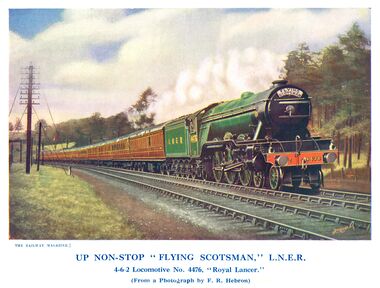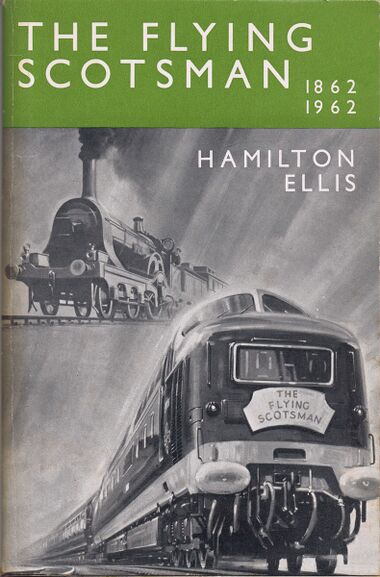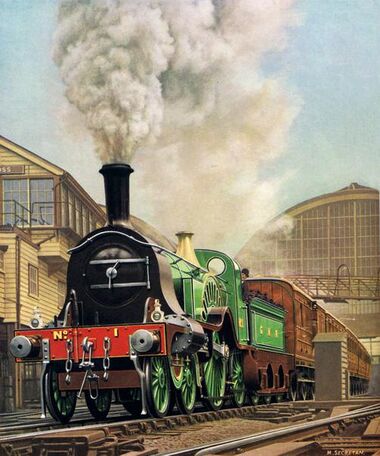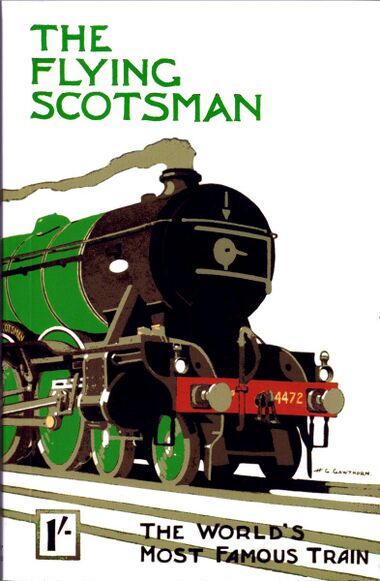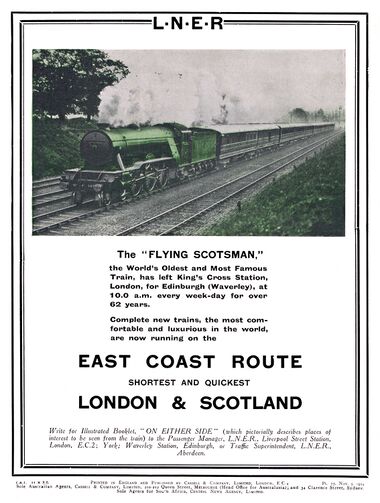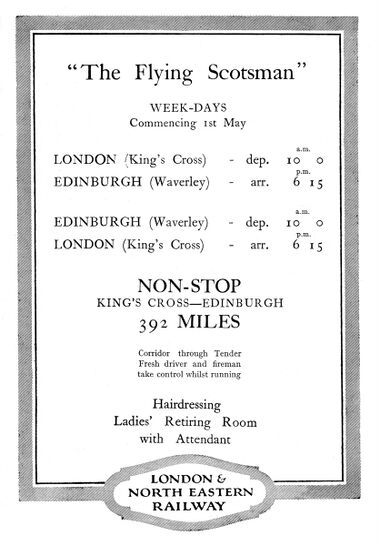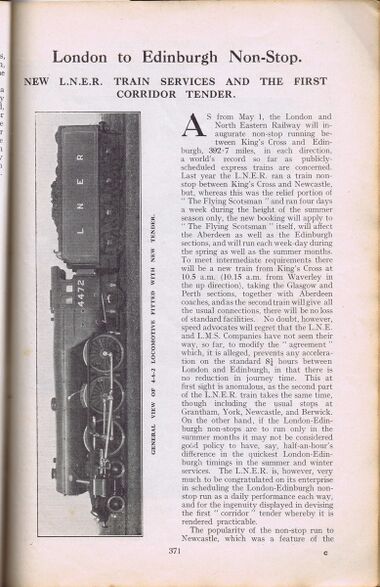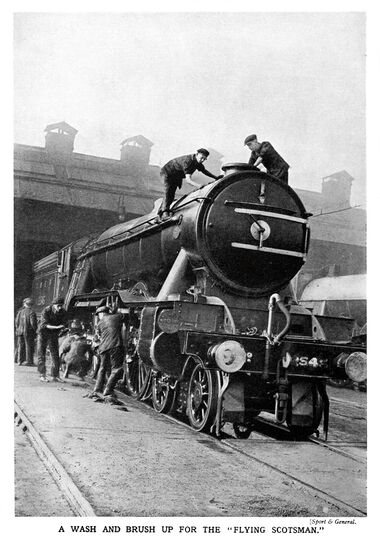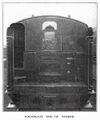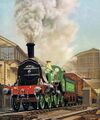Category:Flying Scotsman (train)
1929: The Flying Scotsman, by F. Moore (hauled by 4476 Royal Lancer) [image info]
The Flying Scotsman, 1862-1962, by Hamilton Ellis [image info]
Painting by M. Secretan of a "retro" Flying Scotsman-styled special excursion, hauled by Stirling Single locomotive No.1, and based on the train of 1888. Reproduced in The Railway Magazine, January 1939 [image info]
The Flying Scotsman: The World's Most Famous Train", book cover [image info]
1924: Advert for the Flying Scotsman ("The World's Oldest and Most Famous train"), "East Coast Route" train service (5th November) [image info]
1928: Timetable for the new non-stop service, with onboard hairdresser and "Ladies' Retiring Room" [image info]
1928: Introduction of the new corridor tenders and non-stop service [image info]
"A wash and brush up for the Flying Scotsman". The locomotive is LNER 2545 Diamond Jubilee [image info]
Although the name "Flying Scotsman" is associated in the minds of the general public with the Flying Scotsman locomotive, the name predates the loco, and referred to "The Ten O'Clock" train service that ran simultaneously from London to Edinburgh and Edinburgh to London, originally known as The Special Scotch Express.
1862: The Special Scotch Express
The 10am "Special Scotch Express" train service started running in 1862, running across the North British, North Eastern, and Great Northern Railways' track.
1924: The Flying Scotsman
The train officially adopted its previously-unofficial name The Flying Scotsman in 1924, and a locomotive (number 4472 Flying Scotsman) was given the name to mark the event. The Flying Scotsman locomotive became the publicity darling of the LNER's promotional department, making it one of the country's most famous locomotives. However, since the Flying Scotsman service always used two trains at the same time (one starting in London and one in Edinburgh), even when 4472 was being used on the service, at least 50% of passengers would have been hauled by a different loco.
1928: Non-stop service
The LNER managed to get a second burst of publicity in 1928 by relaunching The Flying Scotsman train as a non-stop service. This was made possible by the design by Gresley of a new type of "corridor" tender – although the locomotives themselves were capable of doing the full journey without stopping, the driver and fireman (who'd be in charge of constantly shovelling coal from the tender into the firebox) couldn't be expected to work in the cramped cab conditions for that amount of time, necessitating a stop by the train to pick up a fresh crew.
The new corridor tender incorporated a small tunnel running through the length of the tender, with a hatch at the driver and and a conventional concertina-style corridor at the other, that allowed it to connect to standard carriages. The relief crew could then travel at the front of the Third Class carriage at the front fop the train for half the journey, and switch positions at half time without having to stop the train.
The new non-stop service didn't seem to be quite as advantageous to the traveller as it seemed, as the train mysteriously then didn't go quite as fast as it could have ... this is usually assumed to have been due to an unofficial agreement between the main train companies not to try to beat each others London-to-Scotland times.
March 1928 article on the new non-stop service
London to Edinburgh Non-Stop.
NEW L.N.E.R. TRAIN SERVICES AND THE FIRST CORRIDOR TENDER.
AS from May 1, the London and North Eastern Railway will inaugurate non-stop running between King's Cross and Edinburgh, 392.7 miles, in each direction, a world's record so far as publicly-scheduled express trains are concerned. Last year the L.N.E.R. ran a train nonstop between King's Cross and Newcastle, but, whereas this was the relief portion of "The Flying Scotsman" and ran four days a week during the height of the Summer Season only, the new booking will apply to "The Flying Scotsman" itself, will affect the Aberdeen as well as the Edinburgh sections, and will run each week-day during the spring as well as the summer months.
To meet intermediate requirements there will be a new train from King's Cross at 10.5 a.m. (10.15 a.m. from Waverley in the up direction), taking the Glasgow and Perth sections, together with Aberdeen coaches, and as the second train will give all the usual connections, there will be no loss of standard facilities. No doubt, however, speed advocates will regret that the L.N.E. and L.M.S. Companies have not seen their way, so far, to modify the "agreement" which, it is alleged, prevents any acceleration on the standard 8+ hours between London and Edinburgh, in that there is no reduction in journey time. This at first sight is anomalous, as the second part of the L.N.E.R. train takes the same time, though including the usual stops at Grantham, York, Newcastle, and Berwick. On the other hand, if the London–Edinburgh non-stops are to run only in the summer months it may not be considered good policy to have, say, half-an-hour's difference in the quickest London-Edinburgh timings in the summer and winter services. The L.N.E.R. is, however, very much to be congratulated on its enterprise in scheduling the London-Edinburgh nonstop run as a daily performance each way, and for the ingenuity displayed in devising the first "corridor" tender whereby it is rendered practicable. The popularity of the non-stop run to Newcastle, which was a feature of the East Coast Anglo-Scottish services last year, made it clear that there is a considerable public demand for improvements of that kind, and the London and North Eastern Railway have for some time been exploring the possibility of extending the distance covered without stopping. It was felt that the limit of the powers of a single engine crew had been reached, and that it was undesirable on grounds of safety to carry two crews on one engine. Some method had, therefore, to be devised by means of which engine crews could be changed en route, and the provision of a corridor on the tender supplied the solution to the problem.This has now been carried into effect, and two of Mr. Gresley's three cylinder Pacific-type engines, i.e., 4472 Flying Scotsman and 4476 Royal Lancer, have been fitted with the new tenders. These will be employed for inaugurating the new London-Edinburgh non-stop runs commencing on May 1, and eight other engines of the same class will be similarly equipped. The driver and fireman in charge on leaving London will be relieved as the train passes Tollerton, 1974 miles from King's Cross, or, roughly, half-way on the journey, the off-duty crew riding in the foremost third-class compartment in the train. On reaching the change-over point the relief crew will pass through the brake van next the engine, and by means of the vestibuled connection with the tender, enter the corridor leading to the footplate, those coming off duty passing back to the train in a similar manner.
The necessity of using a good class of coal on a run of this magnitude is obvious, and a point in this connection is that the engines are equipped with shaking grates. The gangway, or corridor, is located on the right-hand side of the tender looking forward, and entirely covered in. It has a width of 18 in. and a height of 5 ft. Steps at each end of the tender afford access from the level of the gangway or corridor to that of the engine footplate at the front and the vestibule flooring at the rear. Circular windows are provided, one at each end of the corridor, for lighting the interior, and the position of these can be seen in some of the accompanying illustrations. The whole arrangement is neat and compact, The tender is of the eight-wheeled pattern with rigid axles, and weighs in working order 62 tons 8 cwt., as compared with 56.5 tons of the original standard tender, the coal capacity of which was, however, 8 tons in place of 9 tons. A door is provided at each end of the corridor on the tender.
June 1928: Special amenities
... We supplement the foregoing by reference to the special features incorporated in the coaching sets used, notably the inclusion of a section constituting a fully-equipped hairdressing saloon in charge of a competent hairdresser and a ladies' retiring room, in the care of an experienced attendant; and the arrangements Whereby travelling newsman (from W. H. Smith & Son Ltd.) is able to supply newspapers, periodicals and the latest books, including those published for the first time on the day of travel.
The ladies' retiring room is at one end of the coach, with private lavatory adjoining, and is equipped with dressing-table wash-basin, chair, mirror, and cabinets and drawers to enable the attendant to supply perfumery, toilet articles, &c. Next to this, but open only to the corridor, is the hairdressing saloon, where also the attendant has all necessary equipment and a cabinet and cupboard for requisites and articles for sale. Adjoining is a one-sided compartment designed to serve as a waiting room. This opens to the corridor only, so that a customer receiving attention in the hairdressing saloon is not disturbed, and, in the case of ladies, has full privacy. Notices on the respective doors indicate whether either section is "engaged" at the moment.
The waiting room, which seats four, ensures that passengers will not have to return to their compartments if the hairdresser is engaged. The hairdressing saloon and ladies' retiring room are available to all passengers on the train, whether travelling first or third, the train being vestibuled and having corridors throughout.
The travelling newsman is provided with a basket specially constructed to allow him to move freely along the corridors.
Other items of interest in regard to the train are that the kitchen is all-electric, ensuring cleanliness and hygienic conditions; individual seats can be booked beforehand, or compartments reserved (a uniformed attendant is specially allocated to direct passengers to reserved accomodation); and an attendant in uniform travels with the train.
— , -, , Inaugural London-Edinburgh Non-Stop Runs (LNER), , The Railway Magazine, , June 1928
Locomotives
The express service necessarily used a range of locomotive types over the years. A few examples that we've seen in photographs identified as being of the East Coast Express are:
- 371 Hawthorn (1860s)
- The Stirling Singles
- Edward Fletcher's 901 class (1880s)
- The Ivatt Atlantics (e.g. GNR 261)
- 1910s Raven NER Class Z 721
- 1922 North British Railway 510 Lord Provost
- The Gresley A3s (eg Flying Scotsman)
- The streamlined A4's (Mallard-type, e.g. Dominion of Canada)
- 1938: Stirling Single No.1, on special Golden Jubilee trips marking the train's 75th anniversary
- 1960s The English Electric "Deltic" diesels, e.g. D9007 Pinzer
See also:
Further reading
- LNER, The Flying Scotsman: The World's Most Famous Train (LNER, 1925), reprinted as (Shire Books Old House, 2011) ISBN 1908402083 – LNER-produced 1925 book
- Harry Golding (ed), The Wonder Book of Trains, 14th edition (Ward, Lock & Co, circa ~1925) – a noticeably "Flying Scotsman"-centric edition
- Hamilton Ellis, The Flying Scotsman 1862-1962, The Portrait of a Train (Allen and Unwin, 1962)
External links
Subcategories
This category has only the following subcategory.
F
Pages in category ‘Flying Scotsman (train)’
This category contains only the following page.
Media in category ‘Flying Scotsman (train)’
The following 14 files are in this category, out of 14 total.
- A wash and brush up for The Flying Scotsman (WBoR 14ed).jpg 1,402 × 2,000; 900 KB
- Flying Scotsman advert, 1924.jpg 1,511 × 2,000; 605 KB
- Flying Scotsman corridor tender, cab view (TRM 1928-05).jpg 999 × 1,200; 329 KB
- Flying Scotsman corridor tender, rear view (TRM 1928-05).jpg 1,171 × 2,000; 896 KB
- Flying Scotsman corridor tender, through view (TRM 1928-05).jpg 908 × 1,800; 588 KB
- Flying Scotsman LNER 4472 with new tender (TRM 1928-05).jpg 4,337 × 1,265; 1.13 MB
- Flying Scotsman non-stop service (TRM 1928-05).jpg 777 × 1,200; 295 KB
- Flying Scotsman Stirling Single No.1, M. Secretan, small.jpg 503 × 603; 63 KB
- Flying Scotsman, F Moore (TRM 1929-01).jpg 3,000 × 2,273; 4.81 MB
- The Flying Scotsman 1862-1962, portrait of a train, by Hamilton Ellis.jpg 790 × 1,200; 330 KB
- The Flying Scotsman, Bob Gwynne, 0747807701 (Shire Library).jpg 848 × 1,200; 168 KB
- The Flying Scotsman, times, LNER (TRM 1928-05).jpg 835 × 1,200; 201 KB
- Wikimedia Flying Scotsman photograph (F R Hebron).jpg 854 × 464; 96 KB
